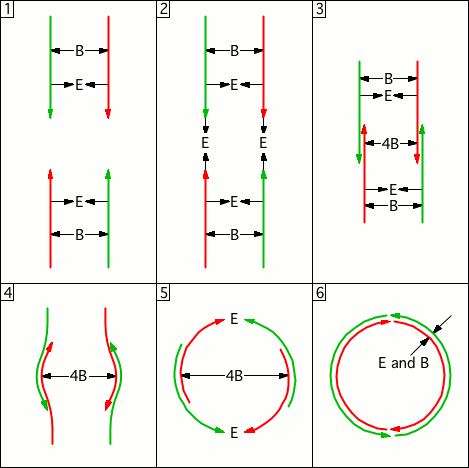ToroidalPlasmoid_wbg.png
© Charles ChandlerToroidal plasmoid formation. The arrows for the positive & negative charge streams (green & red) show the direction of the particle motion, while the arrows for the B & E fields are outward for repulsion and inward for attraction.
- Two charged-separated halves of the filament approach each other (as depicted earlier, in Figure 1). Opposite charges are steered toward head-on collisions, for both electric and magnetic reasons.
- Nearing the collision, an E-field develops between opposite charge streams, pulling them together (as depicted earlier, in Figure 2).
- As the streams burrow through each other, the electric force is satisfied locally, so there is no longer any attraction between the strands in that segment. But the B-field between the strands gets quadrupled, because two repulsions have been doubled.
- The lack of an attractive E-field, and the quadrupled repulsion from the B-fields, force the strands to bulge outward. The effect is the greatest where these factors have been present the longest (i.e., where the collision first started).
- If the charge streams successfully burrow all of the way through each other, and continue out the other side, due simply to their pre-existing momenta, an E-field between the opposite charges gets re-established, steering the streams toward each other. The B-fields generated by the opposing streams (not shown) also favor a head-on collision, as they did in the first panel. (See Figure 3 for how the opposite charges in one strand become coaxial.)
- The four individual charge streams finally resolve into a continuous loop. There will be a toroidal magnetic field wrapping around the annular axis that will keep the streams organized. Electrostatic repulsion between like charges will distribute them evenly around the loop, while attraction between opposite charges will keep the opposing streams bound together.











